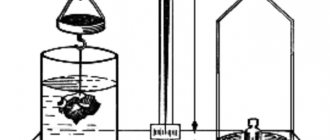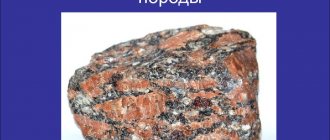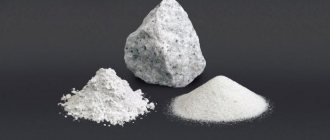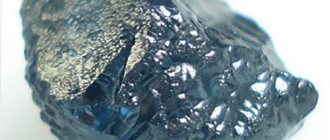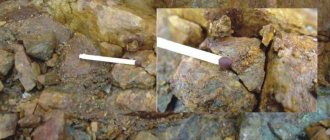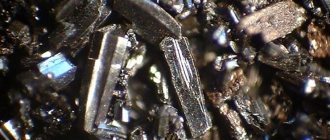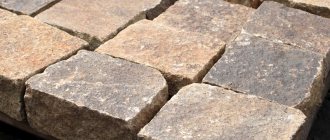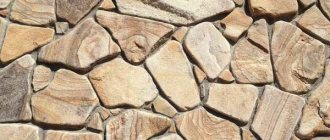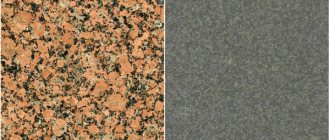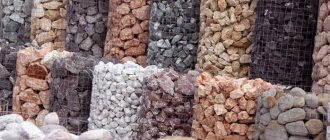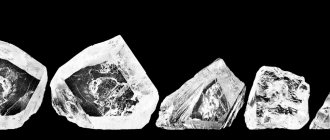"Royal Stone" offers wholesale and retail natural sandstone for cladding and paving in various colors and thicknesses . Order a stone from us!
Sandstone is a large group of clastic sedimentary rocks, which are dominated by clastic grains of minerals, mainly sand from spars, mica, glauconite, quartz, etc., cemented in natural conditions with the help of cement deposits and alumina. The size of the grains included varies from 0.05 mm to 2 mm.
What is sandstone
It is a sedimentary rock found in the superficial part of the earth's crust. The main method of formation is the destruction and transport of rocks by water, followed by cementation of sediments. It is essentially sand cemented naturally under water pressure. The color scheme is dominated by light shades: yellow, beige, red, amber (less often, gray-green, golden, blue). The structure of the stone depends on the deposit, the composition of the fragments, and the type of cement:
- Fine-grained – 0.1-0.5 mm.
- Medium grain – 0.5-1 mm.
- Coarse-grained – 1-2 mm.
Based on the size of the layers, a distinction is made between flat stone (splits into thin, uneven plates) and flagstone - more durable, with a smooth surface and a ring-shaped pattern.
Notes[edit]
- ^ abcdefghijklmnopqrstu vwxyz aa ab ac ad ae af ag ah ai aj ak al Boggs, Sam (2006). Fundamentals of sedimentology and stratigraphy
(4th ed.). Upper Saddle River, NJ: Pearson Prentice Hall. pp. 119–135. ISBN 0131547283. - Prothero & Schwab, Donald R. & Fred (1996). Sedimentary Geology
. W. H. Freeman. paragraph 24. ISBN 0-7167-2726-9. - Swanson, Susan K.; Bahr, Jean M.; Bradbury, Kenneth R.; Anderson, Christine M. (February 2006). "Evidence for Preferential Flow through Sandstone Aquifers in Southern Wisconsin." Sedimentary Geology
.
184
(3–4): 331–342. Bibcode: 2006SedG..184..331S. DOI: 10.1016/j.sedgeo.2005.11.008. - Björlükk Knut; Jaren, Jens (2010). "Sandstones and Reservoir Sandstones." Petroleum Geoscience
: 113–140. DOI: 10.1007/978-3-642-02332-3_4. ISBN 978-3-642-02331-6. - Fundamentals of Geology, 3rd edition, Stephen Marshak, p.182
- Powell, Darryl. "Quartzite". Institute of Mineral Information. Archived from the original on 2009-03-02. Retrieved September 9, 2009.
- ^ab "Basic Classification of Sedimentary Rocks", L.S. Fichter, Department of Geology/Environmental Sciences, James Madison University (JMU), Harrisonburg, VA, October 2000, JMU-sed-classif (accessed: March 2009): separates clastic, chemical-biochemical (organic).
- Leeder, M. R. (2011). Sedimentology and sedimentary basins: from turbulence to tectonics
(2nd ed.). Chichester, West Sussex, UK: Wiley-Blackwell. pp. 3–28. ISBN 9781405177832. - Blatt, Harvey; Tracy, Robert J. (1996). Petrology: Igneous, Sedimentary and Metamorphic
(2nd ed.). New York: W. H. Freeman. pp. 241–242, 258–260. ISBN 0716724383. - Jump up
↑ Blatt and Tracy 1996, pp. 220-227 - Jump up
↑ Blatt and Tracy 1996, pp. 265-280 - ^ B s d e Boggs 2006, pp. 147-154
- ^ ab Choquette, P. W.; Pray, L. C. (1970). "Geological nomenclature and porosity classification of sedimentary carbonates". AAPG Bulletin
.
54
. DOI: 10.1306/5D25C98B-16C1-11D7-8645000102C1865D. - Walker, Theodore R.; Waugh, Brian; Gron, Anthony J. (January 1, 1978). "Diagenesis in first-cycle Cenozoic desert alluvium, southwestern United States and northwestern Mexico." GSA Bulletin
.
89
(1): 19–32. Bibcode: 1978GSAB…89…19W. DOI: 10.1130/0016-7606 (1978) 89 <19: DIFDAO> 2.0.CO; 2. - Jump up
↑ Boggs 2006, p. 148 - Stone, W. Naylor; Seaver, Naylor (1996). "Quantifying compaction, pressure solution, and quartz cementation in moderate to deep bedded quartz sandstones from the Greater Green River Basin, Wyoming". Retrieved October 2, 2020. Cite journal requires |journal= (help)
- Dorrick A. W. Stowe (2005). Sedimentary Rocks in the Field: A Color Guide. Manson Publishing. ISBN 978-1-874545-69-9. Retrieved May 11, 2012.
- ^ a b Francis John Pettyjohn; Paul Edwin Potter; Raymond Seaver (1987). Sand and sandstone. Springer. ISBN 978-0-387-96350-1. Retrieved May 11, 2012.
- ^ a b Prothero, D. (2004). Sedimentary Geology. New York, NN: W. H. Freeman and Company
- Prothero, D.R. and Schwab, F., 1996, Sedimentary Geology, p. 460, ISBN 0-7167-2726-9
- ^ abc Jackson, J. (1997). Glossary of Geology. Alexandria, VA: American Geological Institute ISBN 3-540-27951-2
- Jump up
↑ Boggs, 2006, pp. 130-131. - Carozzi, A. (1993). Sedimentary petrography. Englewood Cliffs, NJ: Prentice-Hall ISBN 0-13-799438-9
- ^ a b Robert H. Dott (1964). “Vake, greywake and matrix; what is the approach to classifying immature sandstones?” . SEPM Journal of Sedimentary Research
.
34
(3): 625–32. DOI: 10.1306/74D71109-2B21-11D7-8648000102C1865D. - "Sandstone: Characteristics, Uses and Problems". www.gsa.gov
. Retrieved August 11, 2022. - Edensor, T. and Drew, I. Building stone in the city of Manchester: St. Anne's Church. Sci-eng.mmu.ac.uk. Retrieved May 11, 2012.
- "Orthoquartzite Definition - mindat.org Glossary". www.mindat.org
. Retrieved December 13, 2015. - ^ab Cravero, Fernanda; and others. (July 8, 2014). "'Piedra Mar del Plata': Argentine orthoquartzite worthy of being considered a 'Global Heritage Stone Resource'" (PDF). Geological Society, London. Archived from the original (PDF) on April 9, 2015. Retrieved April 3, 2015.
Properties of sandstone
The stone is resistant to low temperatures, relatively strong and durable. Natural sandstone successfully replaces softer shell rock and at the same time costs less than dense and heavy granite. Main physical characteristics:
- Density – 2250-2670 kg/m³. Less granite, more shell rock.
- Water absorption is low (0.63-1.57%). The stone practically does not absorb moisture and is therefore frost-resistant (withstands up to 50 freezing/thawing cycles).
- Fire resistance – high. Quartzite sandstones do not lose their properties at temperatures of 1700-1770°C. Rocks with high amounts of silica are used in the production of silica refractory materials for industrial furnaces.
- Porosity is high. Sandstone deposits often contain significant quantities of oil and gas.
- Abrasion is average. The stone is relevant for arranging low-traffic sidewalks and interior floor coverings.
It is worth considering that despite the good indicators of water absorption, frost resistance and abrasion, sandstone is relevant as a street finishing only in the absence of sub-zero temperatures. For example, in the climatic conditions of St. Petersburg, we strongly do not recommend using this stone outdoors.
See also[edit]
- Geological portal
- Dimensional stone is a natural stone that has been cut to specific sizes and shapes.
- List of sandstones - Wikipedia listing article
- Kurkar is the regional name for an aeolian quartz stone on the Levantine coast.
- Sedimentary basin - areas of long-term subsidence that create space for sediment to fill.
- Sydney sandstone
- Yorkstone is a type of sandstone from Yorkshire, England.
Sandstone composition
The composition of sandstone is most often dominated by quartz. Associated minerals are feldspars, mica, glauconite.
Stone is classified according to the minerals it contains. There are the following types of sandstones:
- Monomineral (consist of one mineral): quartz, glauconite.
- Oligomictic (consist of two minerals): mica-quartz, feldspathic-quartz.
- Polymictic (consist of three or more minerals): arkose, greywacke.
When determining the type of sandstone, the composition of the cement is important. Carbonate rocks are considered the highest quality, and clayey rocks the least. Sand grains are also cemented with phosphates, gypsum, iron oxides, chalcedony, and chlorite.
Fossils are often found in the structure of the stone: ancient shells and impressions of fossil animals. This shell sandstone is in great demand in interior design and landscape design.
Components of sandstones (partial review)
Mineral skeleton:
- quartz (usually dominant);
- feldspar (spar >> plagioclase; usually partially altered; microcline > orthoclase);
- rock fragments (flint/quartzite act like quartz; others are not stable);
- heavy minerals (various; most minerals; rare in abundance);
- mica (ordinary, small % shares; muscovite >> biotite);
- clastic carbonates (mixtures are less common than complete structures);
- glauconite (locally, sometimes in quartz-rich rocks).
Empty placeholder:
- quartz (as secondary hypertrophy);
- quartz (in the form of recrystallized amorphous silica);
- flint (amorphous silica);
- calcite (less commonly dolomite);
- hematite (primary or secondary);
- exotic (anhydrite, gypsum, barite, halite, siderite, etc.);
- matrix (fine material, not authigenic);
- fine-grained non-phyllosilicates (quartz, feldspar, carbonates);
- fine-grained phyllosilicates (begin as clay-mineral muds, recrystallize into “sericite”, “white mica”, chlorite);
- phyllosilicate-rich fragments of large rocks.
Sandstone mining
The stone is ubiquitous throughout the world. In Russia, sandstone deposits are concentrated in the Urals, Siberia, Kemerovo and Rostov regions. There are large deposits in Dagestan. In Europe, the stone is mined in Bulgaria, Poland, and Ukraine. The main deposits are located where there were large bodies of water in previous geological eras.
The following methods are used to extract stone:
- Drilling and blasting. Shafts are drilled into the rock into which explosives are placed. The method is relevant for the extraction of quartz and siliceous rocks.
- Stone-cutting. The rock is cut into blocks using special cables.
- Air cushion method. Holes are drilled into the formation into which air is pumped under pressure.
The resulting blocks are sawed and sent to the factory, where they are cut into standard blocks (slabs), ground and polished. To obtain a brighter pattern, the surface of the stone is treated with a special impregnation.
Deposits and methods of stone extraction
The main deposits were found in the steppe and mountainous zones of Kazakhstan, Russia, Ukraine, Dagestan, Bulgaria and Poland. The Donbass field is considered the largest in Europe. The Donetsk and Luhansk sandstone lying in it is formed from spar, quartz, and has the following colors: gray-green, beige, brown, dark gray, yellow.
Crimean savage - mined in mountainous areas, has a gray-green color. Used for making grinding wheels, millstones, paving sidewalks, and cladding plinths.
In Ukraine there are also deposits of decorative sandstones: Ternopilskoye (gray, fine-grained gray-red and scarlet stones) and Yampolskoye (light gray and white stones).
Dagestan sandstone is mined near the villages of Akusha and Chiri. In color, the stone deposited there has warm shades of white, gray, beige or red. Used for the construction of walls, landscape design, and interior design.
In Russia, sandstone is mined in the Rostov, Kemerovo, Moscow regions, the Volga region, the Urals and the Far East.
The Karabash deposit in the Chelyabinsk region is widely known, where there are deposits of mica and quartz flagstone. It produces silver, golden, green, gray and brown types of stone. The remaining deposits contain black, gray, and beige sandstone.
Methods of extraction and processing:
• siliceous and quartz rocks are mined by blasting them, the blocks are sawed into slabs (slabs); • clay or calcareous layers are chopped off and removed from the soil with buckets.
In production, sandstone is cleaned and cut into stones according to standards. The savage is then ground and polished (the treatment is called tumbling). The pattern and texture of the stone are emphasized by impregnation or matte varnish.
Use of sandstone
Stone is mainly used in construction, some types are used for the production of fluxes and refractory materials in metallurgy. Crushed rock (crushed stone) obtained during blasting operations is used for laying foundations, and the crumbs are used in glass production. In addition, sandstone is used to make millstones, grindstones, and phosphate fertilizers. Asphalt is made from bituminous rocks.
Along with granite, marble and limestone, sandstone stone is actively used as a facing material. At the same time, masonry requires a professional approach, since sandstone practically does not absorb moisture, unlike connecting mortar. As a result, moisture penetrates the fastening composition and destroys it quite quickly. For horizontal masonry, a sand-cement mixture in a ratio of 1:4 with the addition of waterproof glue is usually used; for vertical masonry, pure glue can be used.
Sandstone combines harmoniously with other natural materials: wood, granite, marble, and is suitable for decorating gardens and areas adjacent to the house. The combination of sandstone with brick, tiles and other artificial materials looks good.
Types of sandstones by binder
The cementing or binding agent that holds rock sand grains together and gives sandstones its strength can vary.
Most often you can find:
- Calcareous sandstones - calcite or dolomite acts as a binder here;
- Clay sandstones - kaolinite or hydromica act as a binder here;
- Siliceous sandstones - quartz, opal or chalcedony act as a binder here;
- Ferrous sandstones – iron oxides act as a binder here;
- Mixed sandstones - the binder may not be pure, but may have a mixed composition.
In addition, there are sulfate, phosphate, and chlorite sandstones.
Sandstone in architecture and design
Sandstone is applicable for almost all types of facing and decorative landscape works. It has a natural color range (from light yellow to red and brown, greenish, gray), its surface is rough like velvet. The texture can be polished, embossed or scaly. Laying method - tiled or random, with a “torn edge”. Popular for cladding walls, plinths, fences, fireplaces, stairs. In landscape design, natural rubble stone made of sandstone is widely used - for paving paths and sidewalks, creating alpine slides. Crushed sandstone tiles often form a decorative “stone ridge” arrangement. This method is applicable for finishing facades, interior walls, facing fireplaces, as well as in landscape architecture.
GO TO SANDSTONE CATALOG>>
Bibliography[edit]
- Faulk, R.L., 1965, Petrology of Sedimentary Rocks PDF version. Austin: Hemphill's Bookstore. 2nd ed. 1981, ISBN 0-914696-14-9.
- Pettyjohn F. J., P. E. Potter and R. Seaver, 1987, Sand and Sandstone
, 2nd ed. Springer-Verlag. ISBN 0-387-96350-2. - Scholle, P.A., 1978, A Color Illustrated Guide to the Components
,
Textures, Cements, and Porosity of Sandstones and Associated Rocks
, Memorandum of the American Association of Petroleum Geologists, No. 28. ISBN 0-89181-304-7. - Chollet, P.A., and D. Spearing, 1982, Sandstone Depositional Environments: Siliciclastic Sediments
, American Association of Petroleum Geologists. 31. ISBN 0-89181-307-1. - USGS Minerals Yearbook: Stone, Dimension, Thomas P. Dolley, U.S. Department of the Interior, 2005 (format: PDF).
Where can I buy?
In our catalog you can choose sandstone stone for the plinth, façade decoration, and sidewalk paths. Different types of stone available:
- wild,
- ragged,
- tumbled (processed) and non-tumbled,
- in the form of tiles and paving stones.
We are pleased to offer a wide range of sandstone colors: gray-green, yellow-brown, red, burnt. Deliveries from quarries in Russia, delivery throughout Minsk and Belarus. The cost of the stone is from 8 BYN/sq.m. To calculate the total amount, you can use the calculator on our website. And to get a more accurate value, leave a request or call the numbers listed on the website!
History of the origin of the breed
It is necessary to mention the history of sandstone formation, which goes back several million years. People used this stone in the construction of living quarters and shelters 5 thousand years ago. The fact is confirmed by drawings found in old grottoes and caves. The esoteric properties of sandstone have made it possible since ancient times to construct beautiful buildings and complexes from it.
The stone was very popular in those days when France was ruled by Napoleon III. It was sandstone that was chosen for the construction of the tomb of Petra in Jordan, the famous Sphinx in the Egyptian pyramids.
Place of Birth
You can find stone in places where there were oceans or seas a long time ago. The rock is based on grains of sand that have settled to the bottom. It is by this principle that geologists find sandstone deposits.
There are stone deposits in:
- Poland,
- Russia,
- Kazakhstan,
- Bulgaria,
- Dagestan.
The largest deposit in Europe is located in the Donbass.
Loess
Widespread in the south of Ukraine and especially in Central Asia, the non-layered rock is light yellow in color, very delicate to the touch, easily rubbed between fingers into dust. Loess consists of a mixture of tiny grains of quartz and clay particles, with an admixture of up to 30% lime carbonate, which in some places is released in the form of various forms of concretions, usually white (“cranes”). Loess was formed as a result of the accumulation of fine material brought by wind or water. It has a very characteristic vertical separation; due to this, ravines and gorges with steep walls often develop in it.
Due to its high salt content, loess soil is fertile and produces large yields of cultivated plants, especially with artificial irrigation, as, for example, in Central Asia.
Compacted and cemented silts are called silt rocks. In character they are very close to the so-called clay shales, with which they are often mistakenly confused.
Making at home
If it is not possible to purchase natural stone, you can make the material yourself at home. To do this you will need clay, table salt, sand and liquid glass. All ingredients, except salt, should be thoroughly mixed until smooth. Prepare a solution from the salt in which the resulting mixture should be dissolved.
The resulting solution is poured into prepared molds and removed from the open air to dry. In order to save materials, the solution for large products can be prepared directly in molding containers. The remaining mixture can be stored in a tightly closed container in a cool place.
Sandstone is an ancient sedimentary rock. Thanks to its properties and unusual coloring, the stone has found wide application in construction and design art.
